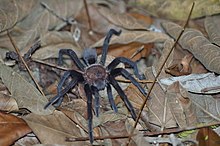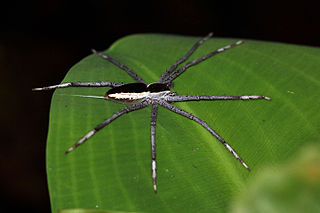
Nursery web spiders (Pisauridae) are a family of araneomorph spiders first described by Eugène Simon in 1890. Females of the family are known for building special nursery webs. When their eggs are about to hatch, a female spider builds a tent-like web, places her egg sac inside, and stands guard outside, hence the family's common name. Like wolf spiders, however, nursery web spiders are roaming hunters that don't use webs for catching prey.

Ctenizidae is a small family of mygalomorph spiders that construct burrows with a cork-like trapdoor made of soil, vegetation, and silk. They may be called trapdoor spiders, as are other, similar species, such as those of the families Liphistiidae, Barychelidae, and Cyrtaucheniidae, and some species in the Idiopidae and Nemesiidae. The name comes from the distinctive behavior of the spiders to construct trapdoors, and ambush prey from beneath them.

Idiopidae, also known as armored or spiny trapdoor spiders, is a family of mygalomorph spiders first described by Eugène Simon in 1889.

Barychelidae, also known as brushed trapdoor spiders, is a spider family with about 300 species in 39 genera.

Migidae, also known as tree trapdoor spiders, is a family of spiders with about 100 species in eleven genera. They are small to large spiders with little to no hair and build burrows with a trapdoor. Some species live in tree fern stems. They have a Gondwanan distribution, found almost exclusively on the Southern Hemisphere, occurring in South America, Africa, Madagascar, Australia, New Zealand and New Caledonia.

Lycosa is a genus of wolf spiders distributed throughout most of the world. Sometimes called the "true tarantula", though not closely related to the spiders most commonly called tarantulas today, Lycosa spp. can be distinguished from common wolf spiders by their relatively large size. This genus includes the European Lycosa tarantula, which was once associated with tarantism, a dubious affliction whose symptoms included shaking, cold sweats, and a high fever, asserted to be curable only by the traditional tarantella dance. No scientific substantiation of that myth is known; the venom of Lycosa spiders is generally not harmful.

Pamphobeteus is a genus of tarantulas that was first described by Reginald Innes Pocock in 1901. It includes some of the largest spiders in the world. They are found in South America, including the countries of Peru, Bolivia, Ecuador, Brazil, Colombia and Panama.

Phormictopus is a genus of spiders in the family Theraphosidae (tarantulas) that occurs in the West Indies, mainly Cuba and Hispaniola, with three species probably misplaced in this genus found in Brazil and Argentina.

Tarantulas comprise a group of large and often hairy spiders of the family Theraphosidae. As of December 2023, 1,100 species have been identified, with 166 genera. The term "tarantula" is usually used to describe members of the family Theraphosidae, although many other members of the same infraorder (Mygalomorphae) are commonly referred to as "tarantulas" or "false tarantulas". Some of the more common species have become popular in the exotic pet trade. Many New World species kept as pets have setae known as urticating hairs that can cause irritation to the skin, and in extreme cases, cause damage to the eyes.

Iridopelma is a genus of Brazilian tarantulas that was first described by Reginald Innes Pocock in 1901.

Pachistopelma is a genus of Brazilian tarantulas that was first described by Reginald Innes Pocock in 1901. As of May 2020 it contains two species, found in Brazil: P. bromelicola and P. rufonigrum. They have a straight front eye row and males have a spinose spur on the first tibia. Females have two spermathecae lacking lobes or constrictions that have a slight curvature in the middle.

Latouchia is a genus of Asian mygalomorph spiders in the family Halonoproctidae, first described by Reginald Innes Pocock in 1901. Originally placed with the Ctenizidae, it was moved to the Halonoproctidae in 2018.
Pterinopelma is a genus of Brazilian tarantulas that was first described by Reginald Innes Pocock in 1901. As of June 2023 it contains two species, found in Brazil: P. felipeleitei and P. vitiosum. It was removed from the synonymy of Eupalaestrus in 2011.

Cyrtopholis is a genus of tarantulas that was first described by Eugène Louis Simon in 1892.

Megaphobema is a genus of tarantulas that was first described by Reginald Innes Pocock in 1901. They look similar to members of Pamphobeteus except for its legs; the third and fourth pairs of legs are much larger and stronger than the first two pairs.
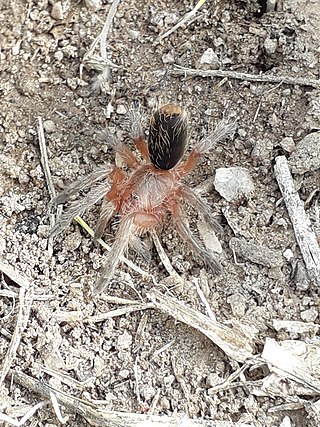
Plesiopelma is a genus of South American tarantulas that was first described by Reginald Innes Pocock in 1901. Plesiopelma species are particularly abundant along mountainous ranges, frequently living under stones. Both males and females live in silk tubes under stones with aggregate spatial distribution. The walls of these tunnels are covered by waterproof silk, protecting them from floods. In addition, there is a uniform saturated microclimate inside the tunnel, which protects the spiders from dehydration.
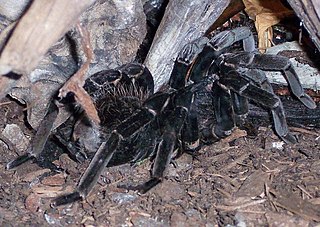
Xenesthis is a genus of tarantulas that was first described by Eugène Louis Simon in 1891. As of February 2024 it contains five species, found in Colombia and Venezuela, though it was previously considered to be found in Panama.
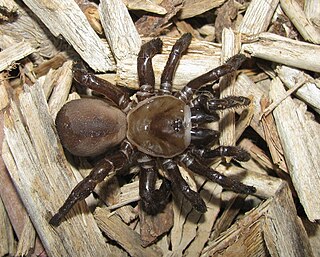
Halonoproctidae is a family of mygalomorph spiders, split off from the family Ctenizidae in 2018. Species in the family are widely distributed in North and Central America, Australasia, Asia, southern Europe and North Africa. One species is recorded from Venezuela in South America. They are relatively large, sombrely coloured spiders, that live in burrows with some kind of trapdoor.
